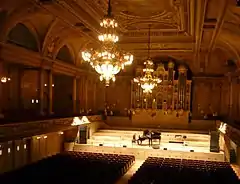Tonhalle, Zürich
The Tonhalle is a concert hall in Zurich, home to the Tonhalle-Orchester Zürich, one of Switzerland's leading orchestras.[1] The 1455-seat hall, located at Claridenstrasse 7 in Zurich, was inaugurated in 1895 by Johannes Brahms.[2][3] The hall is considered to be "acoustically superb".[4] Since 1939, it is part of the building complex Kongresshaus Zürich.
| Tonhalle | |
|---|---|
 Great Hall of the Tonhalle | |

| |
| General information | |
| Location | Zurich, Switzerland |
| Coordinates | 47°21′58″N 8°32′16″E |
| Construction started | 1893 |
| Completed | 1895 |
| Design and construction | |
| Architect | |
| Website | |
| www | |
_2011-08-01_16-40-46_ShiftN2.jpg.webp)
Building
The Tonhalle was built between 1893 and 1895, and designed by the Viennese architects Ferdinand Fellner and Hermann Helmer, who had built the Zurich Opera House and many theaters and concert halls in Europe. The architects had become especially experienced in acoustics, and also achieved excellent acoustics in the Tonhalle.[5] In his comparison of concert halls and opera houses, Leo Leroy Beranek found the Grosser Saal (Great Hall) "an excellent hall", agreeing with three out of four conductors whom he had interviewed, adding "Music critics have generally given high praise to the acoustics".[6] Johannes Brahms conducted his Triumphlied, Op. 55 for the opening on 19 October 1895.[7]
In 1939, the building was changed to a Kongresszentrum for the Swiss National Exhibition of 1939 by the architectural firm Haefeli Moser Steiger. The two concert halls remained mostly unchanged, protected as a historic monument since 1981.
In 1988, the Tonhalle was equipped with a pipe organ built by the firm Kleuker-Steinmeyer.[8] The organist and organ consultant Jean Guillou was instrumental in its design.[9]
Plans to replace the Kongresshaus with a new convention center were submitted in 2006 but rejected in 2008. The Tonhalle will undergo renovation during the 2013/14 season.[10]
Major renovation works on the hall began in 2017, which included the removal of the old organ and installation of a new one. The old organ was donated to the Koper Cathedral in Slovenia.
History
In 1950, Josef Müller-Brockmann produced his first of many concert posters for the Tonhalle concert hall in Zurich, which became known as the Tonhalle Series or "Musica Viva".[11][12] The Tonhalle Series grew increasingly abstract and focused on the feelings of the music.[13][14] Müller-Brockman used a visual form to translate the mathematical system that is found in music, playing with visual scale, rhythm, and repetition, while trying to stay true to each musicians composition who was featured on the poster.[12]
References
- "Tonhalle Orchester Zürich". Allmusic.com. Retrieved 4 December 2011.
- Eckert, Amy; Baker, Mark; McNamee, Dardis (25 May 2011). Frommer's Europe by Rail. John Wiley & Sons. p. 603. ISBN 978-1-118-03350-0. Retrieved 4 December 2011.
- "Culture in Zürich". Zuerich.com. Retrieved 4 December 2011.
- Teller, Matthew; Ratcliffe, Lucy; Reynolds, Kev (June 2003). Rough guide to Switzerland. Rough Guides. p. 198. ISBN 978-1-84353-064-0. Retrieved 4 December 2011.
- "Ausgewählte Ingenieurbauwerke in der Stadt Zürich / Technischer Bericht" (PDF) (in German). n.ethz.ch. 2008. p. 12ff. Retrieved 5 December 2011.
- Leo Leroy Beranek (2004). Concert halls and opera houses: music, acoustics, and architecture. Springer. p. 476. Retrieved 7 December 2011.
- "Tonhalle (Zurich, Switzerland)". haydnphil.org. 2008. Archived from the original on 22 February 2001. Retrieved 7 December 2011.
- "1988 Kleuker-Steinmeyer organ at the Tonhalle in Zürich, Switzerland". pipedreams.publicradio.org. Retrieved 7 December 2011.
- "Jean Guillou". Schott. 2011. Retrieved 7 December 2011.
- "Renovation confirmed for Zürich Tonhalle". gigmag.co.uk. 27 September 2010. Retrieved 7 December 2011.
- Schwemer-Scheddin, Yvonne (Winter 1995). "Reputations: Josef Müller-Brockmann". Eye Magazine. Retrieved 2021-01-01.
- Poulin, Richard (2018-10-02). The Language of Graphic Design Revised and Updated: An illustrated handbook for understanding fundamental design principles. Rockport Publishers. pp. 30–31. ISBN 978-1-63159-617-9.
- Clifford, John (2014). Graphic Icons: Visionaries who Shaped Modern Graphic Design. Pearson Education. p. 115. ISBN 978-0-321-88720-7.
- Purcell, Kerry William (2006). Josef Müller-Brockmann. Phaidon. ISBN 9780714843490.
External links
| Wikimedia Commons has media related to Tonhalle Zürich. |
- Kongresshaus Zürich
- Tonhalle planet-zurich.com (in German)